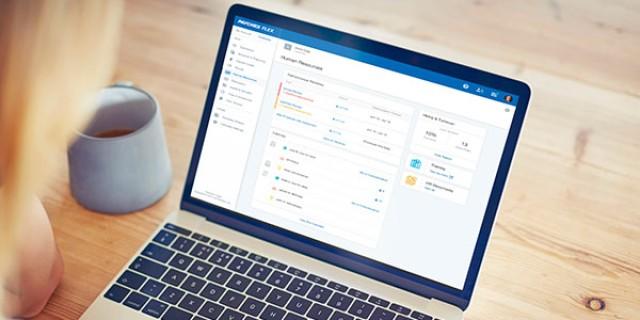- Employee Benefits
- Article
- 6 min. Read
- Last Updated: 08/28/2025
What Is a Section 125/Cafeteria Plan? Benefits and Options To Consider

Table of Contents
With health care costs continually on the rise, a Section 125 plan can not only help augment your employee benefits package, but it can also offer certain employer and employee tax advantages. For instance, a Section 125 plan or cafeteria plan 125 allows employees to pay qualified medical, dental, vision, or dependent care expenses on a pre-tax basis, which can reduce their taxable income as well as their employer's Social Security (FICA) liability, federal income, and unemployment taxes (FUTA), and state unemployment taxes (where applicable).
A robust employee benefits plan is a great way to help you attract and retain talent. When selecting benefit offerings, it's important to provide options that help plan participants save money while strengthening their loyalty to your business. To help you avoid confusion, here are some quick explanations of commonly misunderstood tax-saving benefit options you can offer your employees. Paychex can help you offer Section 125 plans for your small, large, or enterprise-level business today.
What Is a Section 125 Plan?
A Section 125 plan provides employees with an opportunity to receive certain benefits on a pre-tax basis. So, what is a cafeteria plan? It's a program that allows money to be taken out of the individual's gross pay and can be used for items such as group health insurance premiums, qualified out-of-pocket medical expenses, and day care for eligible dependents. For example, if an employee is taxed 30% on their income and they direct $100 of their pre-tax pay to a Section 125 account, they would be able to spend the full amount on qualified medical expenses, rather than only $70 received on an after-tax basis.
Under a Section 125 benefits plan, employers also see a reduction in the amount of income used to determine payroll taxes, resulting in reduced tax liabilities for Medicare, Social Security, and federal unemployment (FUTA). There may also be additional savings on withholding taxes in some states.
What Deductions and Expenses Can Be Written Off With A Section 125 Plan?
Employees can choose to deduct amounts from their gross income to contribute to a Section 125 plan on a pre-tax basis. Both employee participants and employer sponsors of cafeteria plan 125 receive certain tax exemptions related to employee pre-tax contributions. Employee contributions are not subject to federal income tax. Additionally, plan contributions are typically not subject to Social Security tax or Medicare (the combined FICA tax) for the employee participant.
For 2025, the amount an employee can deduct from their gross income depends on the type of benefit. For example, employees can deduct up to $3,300 for a Health Flexible Spending Account (FSA) and up to $5,000 for a Dependent Care Assistance Plan (DCAP).
The mechanism for paying for these expenses varies. For benefits like health insurance premiums, the amount is automatically deducted from an employee's paycheck on a pre-tax basis. For other benefits, such as out-of-pocket medical expenses covered by an FSA, employees pay the provider first and are then eligible for reimbursement from their account funds.
Employer sponsors also receive tax benefits for Section 125 plans. When employees elect to make pre-tax contributions, the amounts are not subject to the employer's share of FICA taxes and federal unemployment taxes. Some state and local taxes may also be affected by these plans.
What Are The Different Types of Section 125 Plans?
As with food service, a cafeteria plan allows employees to pick benefits from a menu of offerings. Any costs beyond the maximum your company will pay then become the responsibility of the employees, paid for via payroll deductions throughout the year. Together with Premium Only Plans (POPs) and FSAs, as well as non-Section 125 plans such as an adoption assistance plan, cafeteria plans allow pre-tax deductions, which may help employees pay less in taxes.
Premium Only Plans (POP)
A Premium Only Plan (POP) is a great way to save on insurance premiums with pre-tax dollars contributing to the overall cost. In combination with group health insurance, a POP reduces taxable income and results in a reduction in the amount used to determine your company's FICA and FUTA payroll taxes, as well as any applicable state taxes.
When setting up this type of Section 125 cafeteria plan, employee participants may have their health care premium payments taken out from their paychecks before taxes are deducted, which in effect reduces the amount of income used for tax calculations. If you're thinking about adding this benefit, it's important to note that a POP may only be offered by an employer with a group medical plan.
Flexible Spending Accounts (FSA)
Offering a Flexible Spending Account through Section 125 can result in major tax savings for your business and your employees. Offered solely in conjunction with a group medical plan, an FSA benefit can help employees budget for predictable out-of-pocket medical expenses, such as co-pays, routine prescriptions, or dental care.
Consider how much an employee's household might spend in a year on eligible expenses with the FSA Calculator tool. Expenses such as maintenance medications (medication taken daily or weekly), yearly eye care, and routine or special-need dental work can all be accounted for. Flexible spending account rules allow pre-tax Section 125 deductions to be used to fund these applicable medical expenses and can lead to significant amounts saved each quarter and year.
Dependent Care Assistance Program (DCAP)
Employees who pay for the cost of caring for a child under the age of 13 or an adult dependent may contribute pre-tax funds to a dependent care assistance program (DCAP). This plan allows workers to pay for up to $5,000 of eligible dependent care expenses with pre-tax dollars, or $2,500 for those with a married filing separately tax status. Covered expenses may include certain adult or child day care, summer camp, or the cost of an in-home caregiver such, as a nanny or au pair.
Note that a DCAP is a broader category of benefits that includes a dependent care FSA (DCFSA), but some key differences exist between the two. While both allow for tax savings, a DCAP may be funded by either the employer or the employee, while a DCFSA is typically funded by the employee. It is important to explain to your staff the plan's financial structure, as some may have a "use it or lose it" rule for unspent funds.
Simple Cafeteria Plans
Small businesses with 100 or fewer employees can offer a simple cafeteria plan. This type of plan is an easier-to-administer alternative to traditional cafeteria plans, allowing employers to receive safe harbor from nondiscrimination tests. To qualify, eligible employers meeting contribution requirements and eligibility and participation requirements can establish a simple cafeteria plan.
Are There Qualifying Events for SEC125 Plans?
An employee who enrolls in a cafeteria 125 plan generally cannot change their benefit elections until the next open enrollment period — unless they experience a qualifying event. A qualifying event is a specific change in an employee's life or family status that allows them to adjust their benefits (and Section 125 deduction) outside of the standard enrollment window.
Common qualifying events for Section 125 cafeteria plan benefits include:
- Marriage, divorce, or legal separation
- Birth or adoption of a child
- Involuntary loss of coverage under another plan (e.g., a spouse's job loss)
- Change in employment status (for employee, spouse, or dependent)
- A dependent aging out of a parent's plan
Pros and Cons of Section 125 Plans
Only you can decide if and when it makes sense for your company to offer a cafeteria plan 125 to employees. In addition to medical, dental, and vision coverage, Section 125 plans are a valuable, cost-saving benefit. Employees enjoy the flexibility of using these accounts so they can better control their tax liabilities. At the same time, employers can defray some of the costs associated with managing other plans.
Consider some of the benefits of cafeteria plan 125:
- Employee Tax Savings: Saves employees on federal, as well as most state and local withholding taxes, while helping them pay for eligible out-of-pocket expenses.
- Lower Taxable Income: Since funds are placed into this account pre-tax, it reduces the amount of taxable income present on a W-2 later in the year.
- Reduction of Employer Payroll and Tax Liabilities: For a business owner, a Section 125 plan helps to reduce payroll and tax liabilities, including FICA and FUTA.
IRS Qualified Benefits Under Section 125
To be included in a Section 125 plan, a benefit must meet the IRS definition of a "qualified benefit."
Qualified benefits may include:
- Health insurance premiums (medical, dental, and vision)
- Accident and disability coverage
- Retirement deposits
- Adoption assistance
- Dependent care assistance
- Group-term life insurance coverage
- Health savings accounts (HSAs)
These benefits can help offset the initial plan setup fee and even help the company save substantially in the long term.
While these plans have many benefits, it's important to examine the potential drawbacks of a cafeteria insurance plan before electing to use them:
- Limited Time Frames: Participants who put funds into a cafeteria insurance plan must use those funds during the plan year, otherwise those funds will be lost. Proper planning is essential from an employee standpoint.
- Employees Fund Expenses Up Front: Employees are reimbursed for expenses as part of a health flexible spending account. This means expenses must be paid out of pocket first and are reimbursed after a claim is made. This could occur when a debit card is not offered to plan participants, or when purchasing an eligible item from a merchant that doesn't accept debit cards. Also, a letter of medical necessity may be required prior to reimbursement from an FSA for some expenses.
- Initial Setup Fees: For the employer, there is an initial setup fee for Section 125 plans. You may want to consider the fee as a one-time investment that could provide significant long-term savings later on. In many cases, this fee is based on the total number of employees. Some providers may also charge ongoing administration fees, so it's important to confirm the full cost structure before implementing the plan.
What Isn't Covered By Section 125/Cafeteria Plans?
While a Section 125 cafeteria plan can help employees save on many qualified expenses, the IRS has strict rules about what can and can't be included. Certain perks simply don't meet the criteria for pre-tax treatment. Here's what doesn't make the list:
- Long-term care coverage
- Tuition assistance or reimbursement
- Employee discounts
- Employer-provided cellphones
- Relocation or moving expenses
- Parking passes, transit passes, or other commuter benefits
- Fitness club or gym memberships
- Small, occasional perks (often called de minimis benefits)
Overall, these drawbacks may not be as problematic as overpaying for other services. You may want to consider speaking to a tax professional about how a Section 125 plan could impact your business directly.
IRS Regulations for Section 125 Plans
Section 125 plans offer tax benefits to both employers and employees when plans are set up in accordance with IRS stipulations. To ensure that your plan qualifies for Section 125 status, you'll need to follow certain rules. First, the rules of the plan must be explained in writing and allow employees to choose between cash or taxable benefits as opposed to the qualified benefits that are available on a pre-tax basis.
When creating a cafeteria plan, employers will need to consider two important rules. First, the Health or Limited Purpose FSA Uniform Coverage Rule requires that the plan's maximum reimbursement amount is available at all times throughout the year. This means that if employees opt to contribute $100 per month, they are entitled to receive the entire $1,200 benefit as of the first day of the plan year. Second, the use-it-or-lose-it rule stipulates that participants in the plan who do not spend their entire balance by the end of the year will forfeit the remaining amount. However, the IRS does give employers the options of offering a 2.5 month grace period or a limited carryover benefit.
As you can see, administering Section 125 plans can be complex and time-consuming. An experienced third-party administrator can offer support by helping you handle the daily tasks associated with these plans and other benefit offerings.
How Do Employers Start a Section 125 Plan?
Premium Only Plans (POP) and flexible spending accounts (FSA) for medical and dependent care benefits are often referred to as Section 125 cafeteria plans because they are each described in Section 125 of the Internal Revenue Code (dependent care under section 129). If you're considering adding one or more of these benefits, it's a good idea to review the IRS Employer's Guide to Fringe Benefits section on cafeteria plans to help you understand the types of benefits that fall under this category.
Often, a third-party administrator can be the easiest route to help you set up a new employee benefits plan and manage day-to-day administration. Many of the respondents in the 2023 Paychex Pulse of HR Survey found that to be true, citing that using HR technology helped them improve the overall employee experience. Moreover, 95% of respondents said they plan to invest in applications to better communicate plan information. Integrated HR technology can also help link benefits and payroll processing to ensure the proper employer and employee contributions are made and taxes are calculated correctly.
Who Can Sponsor a Cafeteria Plan?
If you have employees and pay U.S. income taxes, you're eligible to sponsor a Section 125 cafeteria plan. The flexible benefits of a Section 125 health insurance cafeteria plan aren't limited to large corporations — small businesses, public agencies, and everything in between can take advantage of it, including:
- Sole proprietorships
- Partnerships
- Limited liability companies (LLCs)
- C corporations
- S corporations
- Government entities
How Can Employers Calculate Section 125 Benefits?
One of the most significant advantages of a cafeteria plan is the direct tax benefit it provides to your business. Here's a simple guide on how to calculate your potential Section 125 tax savings:
- Figure out the employee's total earnings before any deductions are made
- Subtract the contributions elected by the employee (e.g., insurance premiums, FSA contributions)
- Withhold federal, state, and local income tax withholdings from this new, lower taxable income amount
- Calculate the business's share of FICA and unemployment taxes based on this reduced taxable income
- Deliver net pay to the employee and remit withheld funds to the appropriate insurance companies and government agencies
This calculation can reveal the financial advantages of Section 125 benefits. Take the first step toward smarter payroll and calculate your POP tax savings today.
Run the Numbers on Your Section 125 Savings
Offering a Section 125 plan is a proven way to reduce your company's payroll tax liabilities while providing valuable tax-saving opportunities for your employees. This benefit helps you create a more competitive compensation package, which can be a powerful tool for employee attraction and employee retention.
The result? Lower costs for you, more take-home pay for your employees, and a benefits package that stands out in today's job market.
Section 125 Frequently Asked Questions
-
What Are the Most Common Types of Section 125 POP Cafeteria Plans?
What Are the Most Common Types of Section 125 POP Cafeteria Plans?
Common POP plans allow for the cost of premiums for medical, dental and vision insurance. Employers may also create these plans to allow for the cost of premiums for disability insurance or group term life insurance.
-
What Is the Difference Between POP and Cafeteria Plans?
What Is the Difference Between POP and Cafeteria Plans?
A cafeteria plan is the overarching term for a Section 125 plan. A Premium Only Plan (POP) is the most basic type of cafeteria plan. It allows employees to pay their portion of group health benefits, dental, and vision insurance premiums with pre-tax dollars. A full cafeteria plan, on the other hand, can include a POP as well as other Section 125 plan benefits like flexible spending accounts (FSAs) and dependent care assistance programs (DCAP).
-
Who is Not Eligible For a Cafeteria Plan?
Who is Not Eligible For a Cafeteria Plan?
Section 125 plans are available to most employees, but IRS criteria specifically excludes certain individuals from participating. This generally includes self-employed individuals, partners in a partnership, LLC members (not LLC-Corp members), and any shareholder who owns more than 2% of an S corporation.
-
Is a 401(k) Plan Considered a Section 125 Benefit?
Is a 401(k) Plan Considered a Section 125 Benefit?
No. A 401(k) plan is a retirement benefit that allows both employer contributions and employee pre-tax salary deferrals. A Section 125 benefit plan is an employer-sponsored plan that allows employees to pay the cost of eligible expenses, such as health care or dependent care, on a pre-tax basis.
-
Are Section 125 Deductions Reported on the Employee's W-2?
Are Section 125 Deductions Reported on the Employee's W-2?
Although not required, employers may report the total value of fringe benefits, including Section 125 plan deductions, in box 14. Employers often use a code like S125 on a W2, which can help an employee who is wondering "what is sec 125 on W2," to understand their total pre-tax contributions.
-
Who Needs a Section 125 Plan?
Who Needs a Section 125 Plan?
A Section 125 plan is useful for any employee that must pay out-of-pocket costs for health care or dependent care. These plans generate tax savings by deducting amounts from an employee's salary on a pre-tax basis to cover eligible expenses and pay their premiums.
Simplify Section 125 Plan Setup With Paychex
Paychex makes it easy to implement Section 125 plans that help both you and your employees save on taxes while enhancing your benefits package. Whether you're a small business or a large enterprise, our solutions are designed to streamline setup and ensure compliance.
Tags









